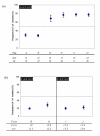Tracking costs of virulence in natural populations of the wheat pathogen, Puccinia striiformis f.sp.tritici
- PMID: 19183485
- PMCID: PMC2660305
- DOI: 10.1186/1471-2148-9-26
Tracking costs of virulence in natural populations of the wheat pathogen, Puccinia striiformis f.sp.tritici
Abstract
Background: Costs of adaptation play an important role in host-parasite coevolution. For parasites, evolving the ability to circumvent host resistance may trade off with subsequent growth or transmission. Such costs of virulence (sensu plant pathology) limit the spread of all-infectious genotypes and thus facilitate the maintenance of genetic polymorphism in both host and parasite. We investigated costs of three virulence factors in Puccinia striiformis f.sp.tritici, a fungal pathogen of wheat (Triticum aestivum).
Results: In pairwise competition experiments, we compared the fitness of near-isogenic genotypes that differed by a single virulence factor. Two virulence factors (vir4, vir6) imposed substantial fitness costs in the absence of the corresponding resistance genes. In contrast, the vir9 virulence factor conferred a strong competitive advantage to several isolates, and this for different host cultivars and growing seasons. In part, the experimentally derived fitness costs and benefits are consistent with frequency changes of these virulence factors in the French pathogen population.
Conclusion: Our results illustrate the variation in the evolutionary trajectories of virulence mutations and the potential role of compensatory mutations. Anticipation of such variable evolutionary outcomes represents a major challenge for plant breeding strategies. More generally, we believe that agro-patho-systems can provide valuable insight in (co)evolutionary processes in host-parasite systems.
Figures



Similar articles
-
Identification of eighteen Berberis species as alternate hosts of Puccinia striiformis f. sp. tritici and virulence variation in the pathogen isolates from natural infection of barberry plants in China.Phytopathology. 2013 Sep;103(9):927-34. doi: 10.1094/PHYTO-09-12-0249-R. Phytopathology. 2013. PMID: 23514262
-
Inheritance of Virulence, Construction of a Linkage Map, and Mapping Dominant Virulence Genes in Puccinia striiformis f. sp. tritici Through Characterization of a Sexual Population with Genotyping-by-Sequencing.Phytopathology. 2018 Jan;108(1):133-141. doi: 10.1094/PHYTO-04-17-0139-R. Epub 2017 Nov 13. Phytopathology. 2018. PMID: 28876207
-
Comparative virulence phenotypes and molecular genotypes of Puccinia striiformis f. sp. tritici, the wheat stripe rust pathogen in China and the United States.Fungal Biol. 2012 Jun;116(6):643-53. doi: 10.1016/j.funbio.2012.03.004. Epub 2012 Apr 2. Fungal Biol. 2012. PMID: 22658310
-
Changes of Races and Virulence Genes in Puccinia striiformis f. sp. tritici, the Wheat Stripe Rust Pathogen, in the United States from 1968 to 2009.Plant Dis. 2017 Aug;101(8):1522-1532. doi: 10.1094/PDIS-12-16-1786-RE. Epub 2017 May 25. Plant Dis. 2017. PMID: 30678601
-
[Research progress in molecular ecology of Puccinia striiformis f. sp. tritici].Ying Yong Sheng Tai Xue Bao. 2008 Mar;19(3):681-5. Ying Yong Sheng Tai Xue Bao. 2008. PMID: 18533544 Review. Chinese.
Cited by
-
Adaptation to resistant hosts increases fitness on susceptible hosts in the plant parasitic nematode Globodera pallida.Ecol Evol. 2016 Mar 14;6(8):2559-68. doi: 10.1002/ece3.2079. eCollection 2016 Apr. Ecol Evol. 2016. PMID: 27066239 Free PMC article.
-
Spatial heterogeneity, frequency-dependent selection and polymorphism in host-parasite interactions.BMC Evol Biol. 2011 Nov 1;11:319. doi: 10.1186/1471-2148-11-319. BMC Evol Biol. 2011. PMID: 22044632 Free PMC article.
-
PrfA regulation offsets the cost of Listeria virulence outside the host.Environ Microbiol. 2015 Nov;17(11):4566-79. doi: 10.1111/1462-2920.12980. Epub 2015 Aug 27. Environ Microbiol. 2015. PMID: 26178789 Free PMC article.
-
Long-distance gene flow outweighs a century of local selection and prevents local adaptation in the Irish famine pathogen Phytophthora infestans.Evol Appl. 2014 Apr;7(4):442-52. doi: 10.1111/eva.12142. Epub 2014 Feb 18. Evol Appl. 2014. PMID: 24822079 Free PMC article.
-
Quantitative Resistance Deployment Can Strengthen Epidemics in Perennial Plants by Selecting Maladapted Pathogen Strains.Evol Appl. 2025 Jul 9;18(7):e70123. doi: 10.1111/eva.70123. eCollection 2025 Jul. Evol Appl. 2025. PMID: 40642029 Free PMC article.
References
-
- Bell G. Selection: the mechanism of evolution. New York: Chapman & Hall; 1997.
-
- Stearns SC. The evolution of life histories. Oxford: Oxford University Press; 1992.
-
- Kassen R. The experimental evolution of specialists, generalists and the maintenance of diversity. Journal of Evolutionary Biology. 2000;15
-
- Frank SA. Coevolutionary genetics of plants and pathogens. Evolutionary Ecology. 1993:45–75. doi: 10.1007/BF01237734. - DOI
Publication types
MeSH terms
Substances
LinkOut - more resources
Full Text Sources

